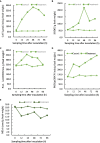Bacillus velezensis BVE7 as a promising agent for biocontrol of soybean root rot caused by Fusarium oxysporum
- PMID: 37928669
- PMCID: PMC10623355
- DOI: 10.3389/fmicb.2023.1275986
Bacillus velezensis BVE7 as a promising agent for biocontrol of soybean root rot caused by Fusarium oxysporum
Abstract
Introduction: Soybean root rot (SRR), caused by Fusarium oxysporum, is a severe soil-borne disease in soybean production worldwide, which adversely impacts the yield and quality of soybean. The most effective method for managing crop soil-borne diseases and decreasing reliance on chemical fungicides, such as Bacillus spp., is via microbial biocontrol agents.
Methods and results: In this study, a soil-isolated strain BVE7 was identified as B. velezensis, exhibiting broad-spectrum activity against various pathogens causing soybean root rot. BVE7 sterile filtrate, at a concentration of 10%, demonstrated significant antifungal activity by inhibiting the conidial germination, production, and mycelial growth of F. oxysporum by 61.11%, 73.44%, and 85.42%, respectively, causing hyphal malformations. The antifungal compound produced by BVE7 demonstrated adaptability to a standard environment. The pot experiment showed that BVE7 suspension could effectively control soybean root rot, with the highest control efficiency of 75.13%. Furthermore, it considerably enhanced the activity of catalase, phenylalanine ammonia lyase, superoxide dismutase, and peroxidase in soybean roots, while also preventing an increase in malondialdehyde activity. By improving the host resistance towards pathogens, the damage caused by fungi and the severity of soybean root rot have been reduced.
Discussion: This study presents the innovative utilization of B. velezensis, isolated from soybean roots in cold conditions, for effectively controlling soybean root rot caused by F. oxysporum. The findings highlight the remarkable regional and adaptive characteristics of this strain, making it an excellent candidate for combating soybean root rot in diverse environments. In conclusion, B. velezensis BVE7 demonstrated potential in effectively reducing SRR incidence and can be considered as a viable option for SRR management.
Keywords: Bacillus velezensis; antifungal activities; biological control; growth-promoting effects; soybean root rot.
Copyright © 2023 Sun, Wang, Zhang, Gao, Cai, Wang and Li.
Conflict of interest statement
The authors declare that the research was conducted in the absence of any commercial or financial relationships that could be construed as a potential conflict of interest.
Figures








Similar articles
-
Bacillus velezensis B105-8, a potential and efficient biocontrol agent in control of maize stalk rot caused by Fusarium graminearum.Front Microbiol. 2024 Oct 16;15:1462992. doi: 10.3389/fmicb.2024.1462992. eCollection 2024. Front Microbiol. 2024. PMID: 39479207 Free PMC article.
-
Genomics assisted functional characterization of Bacillus velezensis E as a biocontrol and growth promoting bacterium for lily.Front Microbiol. 2022 Nov 30;13:976918. doi: 10.3389/fmicb.2022.976918. eCollection 2022. Front Microbiol. 2022. PMID: 36532466 Free PMC article.
-
Antagonistic mechanism of Bacillus velezensis HX0039 as a biocontrol agent against Trichoderma virens-induced "Sanghuang" green mold.Appl Environ Microbiol. 2025 Aug 20;91(8):e0000525. doi: 10.1128/aem.00005-25. Epub 2025 Jul 8. Appl Environ Microbiol. 2025. PMID: 40626662 Free PMC article.
-
The clinical effectiveness and cost-effectiveness of enzyme replacement therapy for Gaucher's disease: a systematic review.Health Technol Assess. 2006 Jul;10(24):iii-iv, ix-136. doi: 10.3310/hta10240. Health Technol Assess. 2006. PMID: 16796930
-
Antidepressants for pain management in adults with chronic pain: a network meta-analysis.Health Technol Assess. 2024 Oct;28(62):1-155. doi: 10.3310/MKRT2948. Health Technol Assess. 2024. PMID: 39367772 Free PMC article.
Cited by
-
Isolation and identification of antagonistic fungi for biocontrol of Impatiens hawkeri leaf spot disease and their growth-promoting potential.Front Microbiol. 2025 May 16;16:1584353. doi: 10.3389/fmicb.2025.1584353. eCollection 2025. Front Microbiol. 2025. PMID: 40454363 Free PMC article.
-
Bacillus velezensis B105-8, a potential and efficient biocontrol agent in control of maize stalk rot caused by Fusarium graminearum.Front Microbiol. 2024 Oct 16;15:1462992. doi: 10.3389/fmicb.2024.1462992. eCollection 2024. Front Microbiol. 2024. PMID: 39479207 Free PMC article.
-
Antagonistic activity of two Bacillus strains against Fusarium oxysporum f. sp. capsici (FOC-1) causing Fusarium wilt and growth promotion activity of chili plant.Front Microbiol. 2024 May 27;15:1388439. doi: 10.3389/fmicb.2024.1388439. eCollection 2024. Front Microbiol. 2024. PMID: 38860216 Free PMC article.
-
Eco-Friendly Biomass Production and Identification of Active Compounds of Paenibacillus polymyxa EB.KN35 with Potent Anti-Fusarium oxysporum Effect.Microorganisms. 2025 Mar 31;13(4):800. doi: 10.3390/microorganisms13040800. Microorganisms. 2025. PMID: 40284636 Free PMC article.
-
Bacillus and Paenibacillus as plant growth-promoting bacteria in soybean and cannabis.Front Plant Sci. 2025 Jun 2;16:1529859. doi: 10.3389/fpls.2025.1529859. eCollection 2025. Front Plant Sci. 2025. PMID: 40525084 Free PMC article. Review.
References
-
- Ahmad R., Arshad M., Khalid A., Zahir Z. A. (2008). Effectiveness of organic-/bio-fertilizer supplemented with chemical fertilizers for improving soil water retention, aggregate stability, growth and nutrient uptake of maize (Zea mays L.). J. Sustain. Agr. 31, 57–77. doi: 10.1300/J064v31n04_05 - DOI
-
- Amin M., Rakhisi Z., Ahmady A. Z. (2015). Isolation and identification of bacillus species from soil and evaluation of their antibacterial properties. Avicenna J. Clin. Microbiol. Infect. 2:23233. doi: 10.17795/ajcmi-23233 - DOI
-
- Buchanan R. E. (1984). Berger bacterial identification manual. 8th ed. Beijing: Science Press.
LinkOut - more resources
Full Text Sources
Miscellaneous

